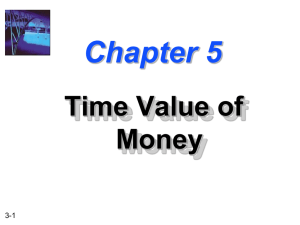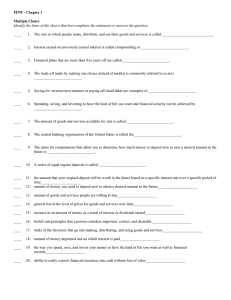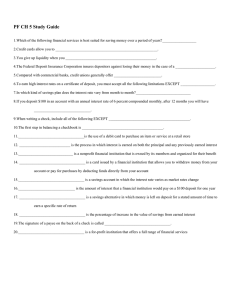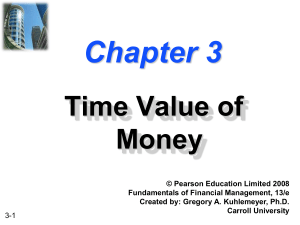Time Value of Money: Finance Fundamentals
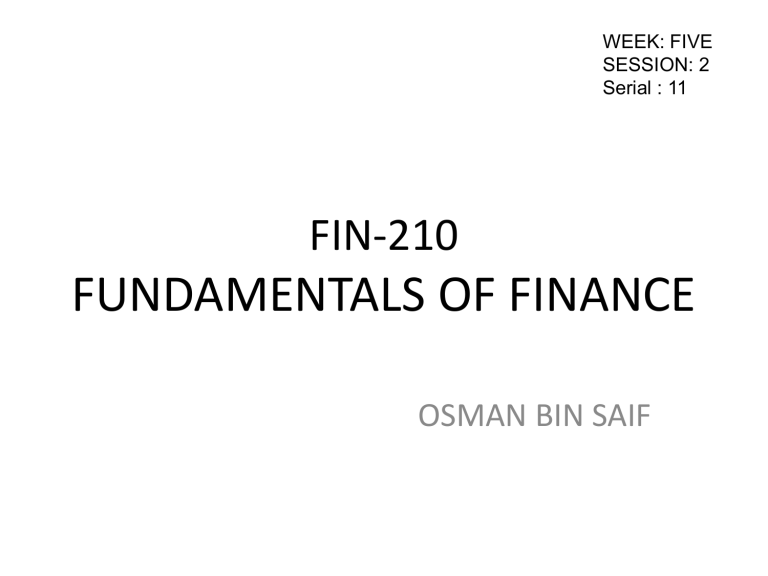
WEEK: FIVE
SESSION: 2
Serial : 11
FIN-210
FUNDAMENTALS OF FINANCE
OSMAN BIN SAIF
Time Value of
Money
The Time Value of Money
• The Interest Rate
• Simple Interest
• Compound Interest
• Amortizing a Loan
• Compounding More Than Once per
Year
The Interest Rate
Which would you prefer -- Rs.10,000 today or Rs.10,000 in 5 years?
Obviously, Rs.10,000 today .
You already recognize that there is TIME
VALUE TO MONEY !!
Why TIME?
Why is TIME such an important element in your decision?
TIME allows you the opportunity to postpone consumption and earn
INTEREST .
Types of Interest
Simple Interest
Interest paid (earned) on only the original amount, or principal, borrowed (lent).
• Compound Interest
Interest paid (earned) on any previous interest earned, as well as on the principal borrowed
(lent).
Simple Interest Formula
Formula SI = P
0
( i )( n )
SI : Simple Interest
P
0
: Deposit today (t=0) i : Interest Rate per Period n : Number of Time Periods
Simple Interest Example
• Assume that you deposit Rs.1,000 in an account earning 7% simple interest for 2 years. What is the accumulated interest at the end of the 2nd year?
• SI = P
0
( i )( n )
= Rs.1,000 ( .07
)( 2 )
= Rs.140
Simple Interest (FV)
• What is the Future Value ( FV ) of the deposit?
FV = P
0
+ SI
= Rs.1,000 + Rs.140
= Rs.1,140
• Future Value is the value at some future time of a present amount of money, or a series of payments, evaluated at a given interest rate.
Simple Interest (PV)
• What is the Present Value ( PV ) of the previous problem?
The Present Value is simply the
Rs.1,000 you originally deposited.
That is the value today!
• Present Value is the current value of a future amount of money, or a series of payments, evaluated at a given interest rate.
Future Value
Single Deposit (Graphic)
Assume that you deposit Rs.1,000 at a compound interest rate of 7% for 2 years .
2
Rs.1,000
FV
2
Future Value
Single Deposit (Formula)
FV
1
= P
0
(1+ i ) 1 = Rs.1,000 (1 .07
)
= Rs.1,070
Compound Interest
You earned Rs.70 interest on your Rs.1,000 deposit over the first year.
This is the same amount of interest you would earn under simple interest.
Future Value
Single Deposit (Formula)
FV
1
= P
0
(1+ i ) 1 = Rs.1,000 (1 .07
)
= Rs.1,070
FV
2
= FV
1
(1+ i ) 1
= P
= P
0
0
(1+ i )(1+ i ) = Rs.1,000 (1 .07
)(1 .07
)
(1+ i ) 2 = Rs.1,000 (1 .07
) 2
= Rs.1,144.90
You earned an EXTRA Rs.4.90
in Year 2 with compound over simple interest.
General Future Value
Formula
FV
1
FV
2
= P
0
(1+ i ) 1
= P
0
(1+ i ) 2 etc.
General Future Value Formula:
FV n
= P
0
(1+ i ) n
Story Problem Example
Kaleem wants to know how large his deposit of Rs.10,000 today will become at a compound annual interest rate of
10% for 5 years .
0
10%
1
Rs.10,000
2 3 4 5
FV
5
Story Problem Solution
Calculation based on general formula:
FV n
FV
5
= P
0
(1+ i ) n
= Rs.10,000 (1+ 0 .10
)
5
= Rs.16,105.10
Double Your Money!!!
Quick! How long does it take to double
Rs.5,000 at a compound rate of 12% per year (approx.)?
We will use the “Rule-of-72” .
The “Rule-of-72”
Quick! How long does it take to double
Rs.5,000 at a compound rate of 12% per year (approx.)?
Approx. Years to Double = 72 / i%
72 / 12% = 6 Years
[Actual Time is 6.12 Years]
Present Value
Single Deposit (Graphic)
Assume that you need Rs.1,000 in 2 years.
Let’s examine the process to determine how much you need to deposit today at a discount rate of 7% compounded annually.
0 1
7%
2
Rs.1,000
PV
0
PV
1
Present Value
Single Deposit (Formula)
PV
0
= FV
2
/ (1+ i ) 2
/ (1+ i ) 2 = Rs.873.44
= Rs.1,000 / (1 .07
) 2 = FV
2
0 1
7%
2
Rs.1,000
PV
0
General Present Value
Formula
PV
0
= FV
1
/ (1+ i )
1
PV
0
= FV
2
/ (1+ i )
2 etc.
General Present Value Formula:
PV
0
= FV n
/ (1+ i ) n
Story Problem Example
Kaleem wants to know how large of a deposit to make so that the money will grow to Rs.10,000 in
5 years at a discount rate of 10% .
0 1 2 3 4 5
10%
Rs.10,000
PV
0
Story Problem Solution
• Calculation based on general formula:
PV
PV
0
0
= FV n
/ (1+ i ) n
= Rs.10,000 / (1+ 0 .10
) 5
= Rs.6,209.21
Types of Annuities
An Annuity represents a series of equal payments (or receipts) occurring over a specified number of equidistant periods.
• Ordinary Annuity : Payments or receipts occur at the end of each period.
• Annuity Due : Payments or receipts occur at the beginning of each period.
Examples of Annuities
• Student Loan Payments
• Car Loan Payments
• Insurance Premiums
• Mortgage Payments
• Retirement Savings
Parts of an Annuity
(Ordinary Annuity)
End of
Period 1
End of
Period 2
End of
Period 3
0 1 2 3
Today
Rs.100 Rs.100
Rs.100
Equal Cash Flows
Each 1 Period Apart
Parts of an Annuity
(Annuity Due)
Beginning of
Period 1
Beginning of
Period 2
Beginning of
Period 3
0 1 2 3
Rs.100 Rs.100
Today
Rs.100
Equal Cash Flows
Each 1 Period Apart
THANKS

